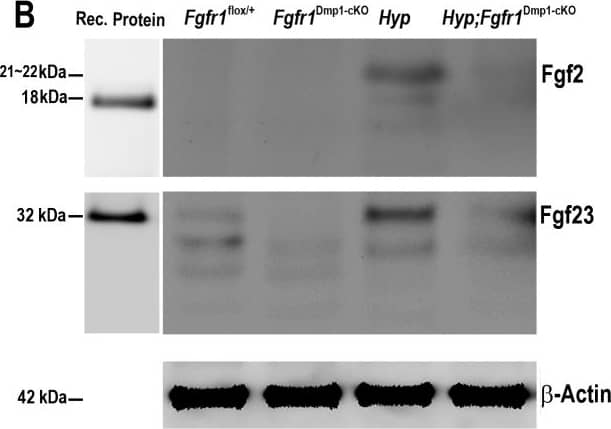Human/Mouse FGF-23 Antibody
R&D Systems, part of Bio-Techne | Catalog # MAB2629

Key Product Details
Species Reactivity
Validated:
Human, Mouse
Cited:
Human, Mouse
Applications
Validated:
Western Blot
Cited:
Co-Immunoprecipitation, Immunohistochemistry, Western Blot
Label
Unconjugated
Antibody Source
Monoclonal Rat IgG2B Clone # 283511
Product Specifications
Immunogen
Mouse myeloma cell line NS0-derived recombinant mouse FGF-23
Tyr25-Val251 (Arg179Gln)
Accession # Q9EPC2
Tyr25-Val251 (Arg179Gln)
Accession # Q9EPC2
Specificity
Detects human and mouse FGF-23 in direct ELISAs and Western blots. Does not cross-react with recombinant human (rh) FGF acidic, rhFGF basic, rhFGF-3, -4, -5, -6, -7, -9, -10, -11, -12, -13, -16, -17, -18, -19, -20, -21, recombinant mouse (rm) FGF‑8b, rmFGF‑8c, or rmFGF-15.
Clonality
Monoclonal
Host
Rat
Isotype
IgG2B
Scientific Data Images for Human/Mouse FGF-23 Antibody
Detection of Mouse FGF-23 by Western Blot
Effects of conditional deletion of Fgfr1 in Hyp osteocytes on gross appearance and bone-related gene expressions in 6-week-old mice.(A) Gross appearance, tail length, and body weight. Compared with control mice, Fgfr1Dmp1-cKO-null mice had normal gross appearance and body weight. However, Hyp mice showed considerably shorter tail length and lower body weight, compound Hyp;Fgfr1Dmp1-cKO-null mice displayed intermediate tail length and body weight between control and Hyp mice. Data are mean ± S.D. from 5–6 individual mice. (B and C) Western blot analysis of total Fgf2 and Fgf23 protein levels in bone. A representative Fgf2, Fgf23, and beta-Actin gel were shown in upper, middle, and lower panels of B, respectively. The intensity of bands was quantified using Image J software (https://rsb.info.nih.gov/ij/), and the data shown in C are mean ± S.D. from three independent experiments. Values sharing the same superscript in different groups are not significantly different at P<0.05. Image collected and cropped by CiteAb from the following publication (https://dx.plos.org/10.1371/journal.pone.0104154), licensed under a CC-BY license. Not internally tested by R&D Systems.Applications for Human/Mouse FGF-23 Antibody
Application
Recommended Usage
Western Blot
1 µg/mL
Sample: Recombinant Human FGF-23 (Catalog # 2604-FG)
Recombinant Mouse FGF-23 (Catalog # 2629-FG)
Sample: Recombinant Human FGF-23 (Catalog # 2604-FG)
Recombinant Mouse FGF-23 (Catalog # 2629-FG)
Formulation, Preparation, and Storage
Purification
Protein A or G purified from hybridoma culture supernatant
Reconstitution
Reconstitute at 0.5 mg/mL in sterile PBS. For liquid material, refer to CoA for concentration.
Formulation
Lyophilized from a 0.2 μm filtered solution in PBS with Trehalose. *Small pack size (SP) is supplied either lyophilized or as a 0.2 µm filtered solution in PBS.
Shipping
Lyophilized product is shipped at ambient temperature. Liquid small pack size (-SP) is shipped with polar packs. Upon receipt, store immediately at the temperature recommended below.
Stability & Storage
Use a manual defrost freezer and avoid repeated freeze-thaw cycles.
- 12 months from date of receipt, -20 to -70 °C as supplied.
- 1 month, 2 to 8 °C under sterile conditions after reconstitution.
- 6 months, -20 to -70 °C under sterile conditions after reconstitution.
Background: FGF-23
FGF-23 is a secreted protein primarily expressed in the brain and thymus. Mutations in FGF-23 produced by osteomalacia tumors are linked to autosomal dominant hypophosphatemic rickets and several bone structure disorders.
Long Name
Fibroblast Growth Factor 23
Alternate Names
FGF23
Gene Symbol
FGF23
UniProt
Additional FGF-23 Products
Product Documents for Human/Mouse FGF-23 Antibody
Product Specific Notices for Human/Mouse FGF-23 Antibody
For research use only
